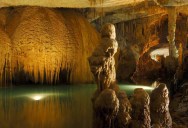The Jeita Grotto Limestone Caves in Lebanon

The Jeita Grotto is a compound of two separate but interconnected karstic limestone caves spanning an overall length of nearly 9 kilometers (5.6 mi). The caves are situated in the Nahr al-Kalb valley within the locality of Jeita, 18 kilometres (11 mi) north of the Lebanese capital Beirut. Though inhabited in prehistoric times, the lower cave was not rediscovered until 1836 by Reverend William Thomson; it can only be visited by boat since it channels an underground river that provides fresh drinking water to more than a million Lebanese.
In 1958, Lebanese speleologists discovered the upper galleries 60 metres (200 ft) above the lower cave which have been accommodated with an access tunnel and a series of walkways to enable tourists safe access without disturbing the natural landscape. The upper galleries house one of the world’s largest stalactites at 8.2m in height (26.9 ft). The galleries are composed of a series of chambers, the largest of which peaks at a height of 120 metres (390 ft).
The Jeita Grotto is also one of 28 finalists to become one of the new 7 Wonders of Nature! [Source]
2.

3.

4.

5.

6.

The Jeita Grotto Limestone Caves in Lebanon
Ancient vestiges of a foundry were found in a smaller cave near the Nahr al-Kalb river, suggesting that the cave was used in antiquity to produce swords.
The modern discovery of the underground river of Jeita in 1836 is credited to Reverend William Thomson (an American missionary) who ventured some 50 metres (160 ft) into the cave. Reaching the underground river, he fired a shot from his gun and the resulting echoes convinced him that he had found a cavern of major importance.
In 1958 the lower caverns were opened to the public, meanwhile exploration was still underway mainly by the Lebanese Caving Club. This exploration led to the discovery of the elevated dry branch of the grotto later referred to as the upper galleries. The caverns closed to the public due to the Lebanese civil war in 1978 both tunnels leading to the lower and upper galleries were used to store munitions, the outside buildings for military purposes. The caves reopened in 1995 and remain one of the country’s key natural attractions. [Source]
7.

8.

9.

10.

11.

The Jeita Grotto Limestone Caves in Lebanon Continued…
The Jeita caves are solutional karst caves which have formed over millions of years due to the dissolution of limestone. The limestone is dissolved by carbonic acid charged rain water and groundwater; when the limestone, which is originally water proof, contains cracks produced by tectonic forces, the water oozes into the rock and starts to widen the cracks and solute caves inside the layers.
Jeita is the longest cave complex in the Middle East; it sits at 300 metres (980 ft) above sea level and has a height difference of 305 metres (1,001 ft). Geologically, the caves provide a tunnel or escape route for the underground river, which is the principal source of Nahr al-Kalb.
The Jeita grotto is the longest explored cave in Lebanon. After many years of exploration, speleologists have penetrated about 6,200 metres (20,300 ft) from the entry point of the lower grotto to the far end of the underground river and about 2,130 metres (6,990 ft) of the upper galleries.
Today, the Jeita Grotto is a popular recreational show cave and a major tourist attraction. It hosts approximately 280,000 visitors per year. The Jeita grotto contributes significantly to the public life of the region. MAPAS, the firm which runs the grotto, is an important employer and provides full time jobs for around 115 local residents of Jeita (30% of which are female).
In addition to employment, the Jeita caves contribute 5% of ticket fees to the local municipality, between 10 and 20% of general revenue to the Lebanese ministry of tourism, and an additional 10% of ticket fees along with the 10% VAT to the Lebanese ministry of Finance. Moreover, the Jeita cave emits a spring with a flow ranging from 1–2 m³/sec, providing fresh drinking water for one-and-a-half million inhabitants of the capital, Beirut. However, water pollution, due to domestic and agricultural runoff, remains a serious concern as recent analysis detected an increasing presence of coliform bacteria. [Source]
12.

13.

14.

15.

16.

If you enjoyed this article, the Sifter highly recommends:




